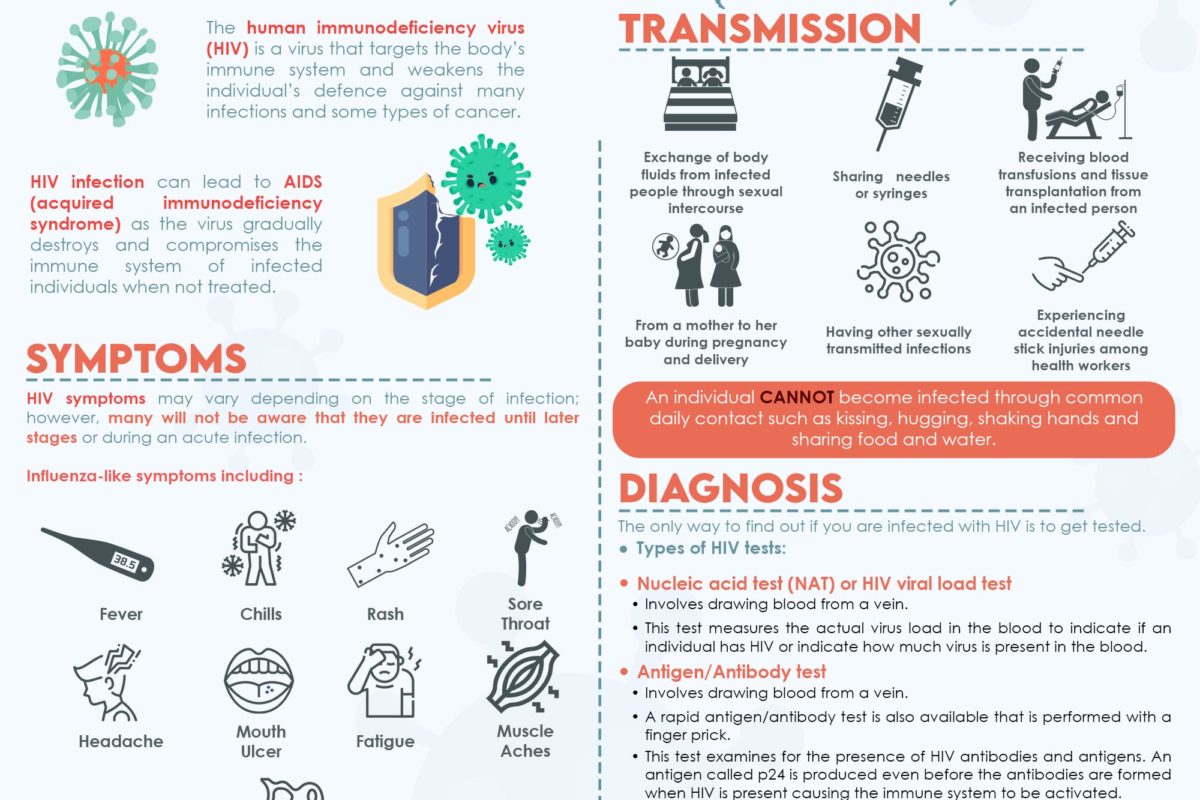About HIV and AIDS | Symptoms, Transmission and Diagnosis
The human immunodeficiency virus (HIV) is a virus that targets the body’s immune system and weakens the individual’s defence against many infections and some types of cancer.1, 2, 3, 4, 5 HIV remains as a major public health issue globally, having infected an estimated 38 million lives at the end of 2019.2, 6
HIV infection can lead to AIDS (acquired immunodeficiency syndrome) as the virus gradually destroys and compromises the immune system of infected individuals when not treated. Immunodeficiency occurs as a result of heightened susceptibility to a wide range of infections, cancers and other diseases which presents with severe long term clinical manifestations.1, 2, 4, 7
HIV symptoms may vary depending on the stage of infection, however, many will not be aware that they are infected until later stages or during an acute infection.1, 2 Some individuals may experience an influenza-like symptoms including fever, chills, rash, sore throat, headache, mouth ulcer, fatigue, muscle aches and swollen lymph node in the first few weeks after an initial infection. These individuals can also develop severe illnesses such as tuberculosis, cryptococcal meningitis, severe bacterial infections, lymphomas and Kaposi’s sarcoma when the HIV infection is left untreated.2
Most individuals who get infected with HIV get it through the exchange of body fluids from infected people through sexual intercourse, sharing needles or syringes and receiving blood transfusions and tissue transplantation from an infected person. HIV can also be transmitted from a mother to her baby during pregnancy and delivery, experiencing accidental needle stick injuries among health workers as well as having other sexually transmitted infections will increase having HIV infection.2, 5, 9 However, an individual cannot become infected through common daily contact such as kissing, hugging, shaking hands and sharing food and water.2, 5, 10
The only way to find out if you are infected with HIV is to get tested. The HIV diagnostic test that is most widely used, detects antibodies made by the individual as an immune response to fight HIV. In most cases, the antibodies to HIV will develop within 28 days of infection. During this time, the individual will experience a ‘window period’; when the HIV antibodies have not been produced in high enough levels to be identified by standard tests or when they do not exhibit signs of HIV infection but are able to transmit the virus to others. As for children below 18 months old, serological testing is not sufficient to detect an HIV infection, hence, virological testing must be performed as early as birth or at 6 weeks old.2, 5
Currently, there is no cure for HIV but there are efficient drug treatments which allow most individuals with the virus to live a longer and healthy life. With a timely diagnosis and effective interventions, most HIV patients will not develop AIDS- related illnesses and will be able to have a close-to-normal lifespan.5
There are three types of tests available such as nucleic acid tests (NAT), antigen/antibody tests, and antibody tests which are typically performed on blood or oral fluid. Nucleic acid test (NAT) or HIV viral load test involves drawing blood from a vein. 11 This test measures the actual virus load in the blood to indicate if an individual has HIV or indicate how much virus is present in the blood. Antigen/Antibody test involves drawing blood from a vein. A rapid antigen/antibody test is also available that is performed with a finger prick. This test examines for the presence of HIV antibodies and antigens. The antibodies for HIV are produced by the immune system when an individual is exposed to HIV viruses. The p24 antigen is produced even before the antibodies are formed when HIV is present causing the immune system to be activated. HIV antibody test involves drawing blood from a vein, from a finger prick or with oral fluid. This test examines for the presence of HIV antibodies only which is produced when an individual is exposed to HIV viruses. It is the most rapid test which is the only approved self-test currently.
References:
- About HIV. (n.d.). Centers for Disease Control and Prevention. Retrieved November 24, 2020, from https://www.cdc.gov/hiv/basics/whatishiv.html
- HIV/AIDS. (2020, July 6). World Health Organization. https://www.who.int/news-room/fact-sheets/detail/hiv-aids
- Cheng, D. C. K. C. (n.d.). What is HIV? MyHealth Kementerian Kesihatan Malaysia. Retrieved November 23, 2020, from http://www.myhealth.gov.my/en/hivaids-2/
- Wan Mohammad, D.W.M.W.M. (n.d.). http://www.myhealth.gov.my/en/hiv-aids/.
- HIV and AIDS. (n.d.). NHS. Retrieved November 24, 2020, from https://www.nhs.uk/conditions/hiv-and-aids/
- Wang, H., Wolock, T. M., Carter, A., Nguyen, G., Kyu, H. H., Gakidou, E., … & Coates, M. M. (2016). Estimates of global, regional, and national incidence, prevalence, and mortality of HIV, 1980–2015: the Global Burden of Disease Study 2015. The lancet HIV, 3(8), e361-e387.
- Basant Singh, D. H. K. (n.d.). HIV/AIDS. MyHealth Kementerian Kesihatan Malaysia. Retrieved November 23, 2020, from http://www.myhealth.gov.my/en/teen-hivaids/
- MyHealth Kementerian Kesihatan Malaysia. Retrieved November 23, 2020, from http://www.myhealth.gov.my/en/hiv-aids/
- HIV Transmission. (n.d.). Centers for Disease Control and Prevention. Retrieved November 25, 2020, from https://www.cdc.gov/hiv/basics/transmission.html
- Ways HIV is not transmitted. (n.d.). Centers for Disease Control and Prevention. Retrieved November 25, 2020, from https://www.cdc.gov/hiv/basics/hiv-transmission/not-transmitted.html
- Types of HIV tests. (2020, October 20). Centers for Disease Control and Prevention. Retrieved November 25, 2020, from https://www.cdc.gov/hiv/basics/hiv-testing/test-types.html



